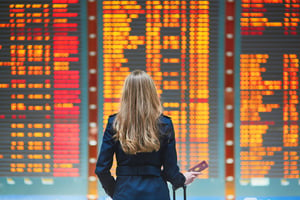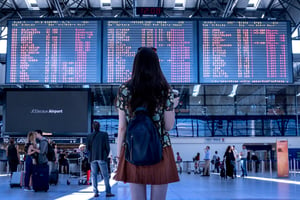I used to travel a ton in my past life in consulting – I remember waking up every Monday morning at...
How much are flight disruptions really costing your organization?
5 reasons your company needs proactive flight delay alerts
Articles discussing the financial impacts of flight delays are not hard to find. However, there isn’t much out there that puts a number or methodology to valuing the impact to the business traveler and more specifically the companies they work for.
In the US alone, over 500 million business trips were taken in 2016. Some businesses will see their employees collectively experience thousands of hours of delay in a given year, but how does one quantify the financial impact of this?

There are multiple methodologies one could use to get at this value. The US Department of Transportation has recommendations for the value of traveler time, separated by business vs leisure, but it is based on wage rates and quite general to the population, leaving much to be desired in terms of comprehensiveness in valuing the impacts to businesses and their travelers.
Alternatively, one could try to estimate hard actual costs businesses incur, but that leaves out some of the less tangible impacts.
Another approach is to survey travelers’ willingness to pay values—which are the equivalent dollar amounts a traveler would pay to reduce one hour of travel time, like one University of California at Irvine study did. The study explored how the value of a traveler’s transit time can vary greatly by environmental factors, such as opportunities for productivity, enjoyment of the time, and levels of stress. A situation where there is a lot of noise, discomfort, physical exertion, and concern about missed connection will be considered of higher value (willing to pay a higher price to avoid) than a situation where the traveler is relaxed and happy, and perhaps with a good internet connection and power outlets for productivity.
In terms of willingness-to-pay (WTP), the study found that the average business traveler would pay $286 to reduce delay time by one hour. This was broken down further by income:

Willingness to pay estimates can give us some indication of the value of the business travelers’ time, but also isn’t perfect for measuring the business costs associated with delays.
Based on experience and conversations with businesses, experts at Lumo have created their own methodology for categorizing and estimating the costs of flight disruptions.
The costs of disruptions have been broken into 5 categories:

Traveler Productivity

Delays impose on both working and personal hours of travelers, each of which have an impact on productivity in the workplace.
The value of lost productivity may vary by the ability of the traveler to be productive during his or her trip. Lower productivity = higher costs. Limitations to productivity during delays may include privacy, space and comfort, access to power outlets, internet connection, and continuity of work (ie needing to deal with ticket counters, boarding etc. may lead to loss of continuous workflow).
Companies must also consider the impact of travel on their employees’ health, as this Harvard Business Review study did. The study found a strong correlation between frequent business travel and many health concerns, including obesity. Healthy employees will certainly be more productive, and spend less days out of the office due to illness.
Proactive flight delay alerts can help travelers to avoid delays altogether, or plan ahead when one is expected to minimize productivity loss. This could be in the form of arriving to the airport late, rescheduling plans, or just being able to get comfortable in one spot in an airport to allow for an uninterrupted working session.
Estimated Value: $50-$200 per hour of delay
Traveler Burnout

Employees who travel frequently have often cited their travel demands and stress as a top reason for leaving their jobs, and numerous surveys have shown delays to be among the top stressors during travel. Getting home late, spending extra nights at the destination location, and all the other inconveniences that come with a delay only compound the problem.
Delays have also been getting worse over time, and the impact on the traveler’s time is significantly worse than the actual delay time. Researchers at MIT found that when missed connections and flight cancellations are considered, the average impact on the traveler was 66% greater than the stated delay time.
Acknowledging this, it’s fair to make the statement that: Fewer Delays => Happier Travelers => Reduced Attrition.
When considering the value of reduced attrition, one should consider the cost of replacing an employee, which can be upwards of $50,000 when considering the recruiters’ time, the interviewers’ time, on-boarding time, and lost productivity.
Estimated Value: $10-$200 per hour of delay
Business Impacts

Lost productivity in the form of missed meetings, or lost or delayed deals is a significant contributor to business costs associated with flight delays and cancellations. This won’t be a factor with every delay, but when it is it can be significant enough to skew the average cost per hour in this category upward.
The business impact cost may also vary by the travelers’ seniority and role in the company.
Estimated Value: $50-$400 per hour of delay
Travel Expenses

Delays lead to more food, drinks, and consolation desserts.
They can also lead to hotel costs, extra cab rides, and extra entertainment. Costs in this category can be seen clearly on a balance sheet.
Estimated Value: $10-$20 per hour of delay
Peace of Mind/Reduced Uncertainty

“Is my flight going to be delayed?” That is the question in the background of every travelers’ mind all the way up until the time they board the plane. This worry, or uncertainty, has an intangible cost associated with it.
The UC - Irvine study showed that “[travelers will] pay a premium to reduce the uncertainty of any particular component of travel time, the amount depending on how that component affects their likelihood of delays.”
The study also showed that “worry about missed connections is a top cause of stress, thus increasing the cost of the traveler’s time. Therefore, travelers will likely place a higher value on time spent on travel that precedes a connecting flight than time at the end of their trip.”
It’s also comforting to know if your flight is not likely to be delayed.
We consider this cost on a per-flight basis, as opposed to a per-hour basis like the other cost components, as it exists whether or not a delay occurs.
Estimated Value: $1-$20 per flight (higher for connecting flights than flights to final destination)
The Solution
Proactive flight alerts, currently only offered by Lumo, can help mitigate these costs. The alerts allow travelers to book lower risk flights, change their itinerary to avoid risk after booking, as well as stay informed about their delay risk throughout the entire travel journey.
To see how much time and money that proactive delay alerts from Lumo could save your company, check out our:






